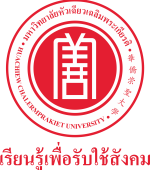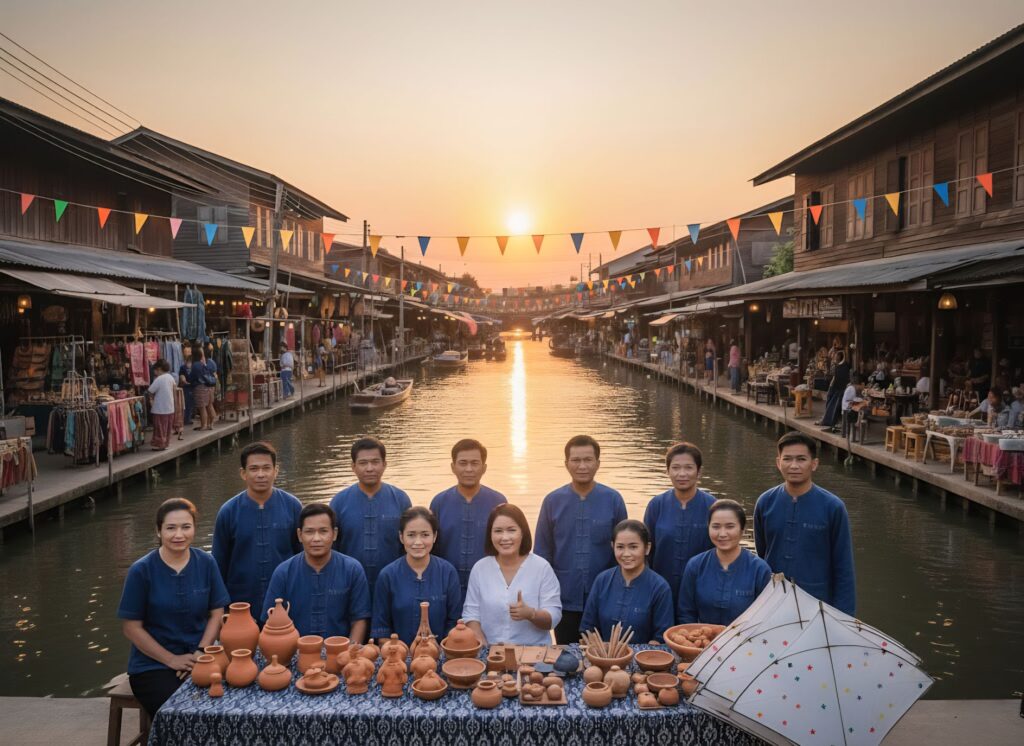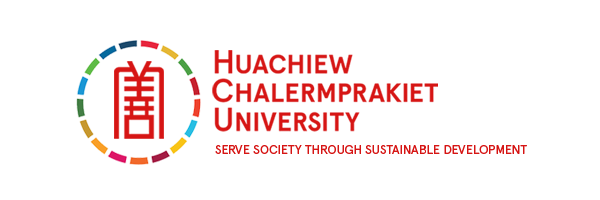
Huachiew Chalermprakiet University
Thailand
From Heritage to Livelihoods: A Three-Phase Area-Based Study
on Cultural Capital and Inclusive Community Development
Category: Research Project of the Year Arts, Humanities and Social Sciences
Overall Abstract
Area-based research is increasingly recognized as a vital strategy for linking academic knowledge with community-driven development, especially in rapidly changing localities. Guided by its motto “To pursue knowledge to serve society,” Huachiew Chalermprakiet University (HCU) has implemented a longitudinal, three-phase cultural capital research initiative that aligns with Thailand’s national strategy to uplift grassroots communities while ensuring that development remains both inclusive and sustainable.
The project began with the identification and documentation of local cultural capital. More than 150 tangible and intangible assets—including rituals, local cuisine, handicrafts, and performing arts—were mapped into a “cultural capital mapping,” This repository became a reference point from which communities themselves could select the elements they considered most valuable to preserve, strengthen, and transmit to future generations. Such an approach ensured that the research was not externally imposed but rooted in local priorities and community voice.
Building on this foundation, the second phase concentrated on developing and enhancing products, services, and competencies derived from the chosen cultural capital. Participatory training programs and collaborative frameworks, such as the Temple-School-Community-Entrepreneur (TSCE) model, supported local entrepreneurs in transforming heritage into sustainable livelihoods. More than 20 new cultural products and services were created, including revitalized folk performances, redesigned traditional desserts, handicrafts from water hyacinth, and community-based tourism initiatives. Six cultural enterprises were established, and entrepreneurs recorded income increases ranging from 50% to 327%. Cultural markets such as the Srivaree Floating Market were revitalized as platforms for sustaining these enterprises. Importantly, the process relied on deep participation, with local elders, artisans, and performers transferring their knowledge to younger generations, creating over 800 cultural successors who are now engaged in safeguarding and expanding community heritage.
The third phase expanded both the geographic coverage and the inclusivity of the program. Initially focused on Thai cultural heritage, the scope was broadened to involve migrant workers, persons with disabilities (PWDs), and other vulnerable groups. This inclusive approach fostered intercultural understanding and strengthened social cohesion across diverse populations, making cultural heritage a unifying force for community development.
The initiative was made possible through approximately USD 203,125 in research funding provided by the Thai government, complemented by substantial in-kind support from local government units and NGOs, including venues, logistical assistance, and co-organized cultural events. This collective investment, coupled with strong community participation, achieved a Social Return on Investment of 8.48 (Phase 2) and 4.96 (Phase 3) and a Return on Investment of 35.63, providing clear evidence of the value of investing in cultural capital as a foundation for economic and social resilience.
Taken together, the three phases of this longitudinal research initiative demonstrate that cultural capital can be more than a symbol of heritage: it can be a driver of livelihoods, innovation, and inclusion. The outcomes—ranging from revitalized traditions and thriving local enterprises to intercultural solidarity and improved livelihoods—affirm that area-based research can generate tangible socio-economic returns while preserving cultural identity. This work offers a proven model for integrating culture, community, and economy in the pursuit of inclusive and sustainable development.

Phase 1: Research and Development of Cultural Capital on Both Sides of the Canal in Bang Sao Thong District, Samut Prakan Province (2019-2021)
The research project, “Research and Development of Cultural Capital on Both Sides of the Canal in Bang Sao Thong District, Samut Prakan Province,” was funded by the Thailand Science Research and Innovation (TSRI). The study aimed to achieve four primary objectives: (1) to develop comprehensive cultural maps of the targeted areas through collaboration among five key stakeholder groups—higher education institutions, civil society, communities, government and local authorities, artists, and the private sector—with the resulting cultural maps disseminated via publications, websites, and applications; (2) to establish cultural areas and/or activities created or enhanced in conjunction with these partners; (3) to develop cooperative mechanisms for promoting cultural entrepreneurship in collaboration with stakeholders; and (4) to realize spatial development outcomes derived from artistic and cultural capital, with measurable economic and social impacts.
The study yielded the following outcomes: (1) A detailed cultural map documenting tangible and intangible cultural heritage through stakeholder collaboration, published across multiple media platforms in both print and digital formats; (2) The creation of a cultural area at Hua Khu Temple, incorporating diverse activities such as the Haephahom Luang Pho Khiao Sukkophuttophakhawa Festival, a cultural courtyard, and the Lanpunsuk garden, all developed collaboratively with partners; (3) The establishment of a network for area management grounded in cultural and environmental capital, promoting cultural entrepreneurship across four domains: performing arts, tourism, handicrafts, and local food; and (4) An assessment of economic and social returns on investment (ROI/SROI) for activities developed from artistic and cultural capital, indicating that 5 out of 7 activities demonstrated positive returns, corresponding to a success rate of 71.43% across assessed projects.
This research demonstrates the potential of strategic cultural capital development to enhance local identity, support sustainable entrepreneurship, and generate measurable socio-economic benefits through collaborative, community-based initiatives.
Keywords: Cultural Capital, Cultural Mapping, Cultural Entrepreneurship, Community Development, Social Impact
EXECUTIVE SUMMARY
The project “Research and Development of Cultural Capital on Both Sides of the Canal in Bang Sao Thong District, Samut Prakan Province” developed cultural maps of the targeted areas through cooperation with multiple partners. These cultural maps were published in both printed and online media. Hua Khu Temple was included in the cultural map, which highlighted a variety of cultural activities created or developed collaboratively with partners. The research also established area management strategies based on cultural and environmental capital, supporting the promotion of cultural entrepreneurs.
Additionally, the project assessed economic and social returns on investment (ROI/SROI) for activities developed from art and cultural capital. The outputs, outcomes, and recommendations are summarized as follows:
1. Results of Activities
Activity 1: Creating Cultural Maps in Bang Sao Thong District
The project identified, documented, and compiled 45 cultural heritage sites along three canals in Bang Sao Thong District, including 21 tangible and 24 intangible heritages. Surveys of birds and plants recorded 14 bird families with 20 species, 13 families with 21 species in temples, and 20 families with 37 species in mango orchards and fishponds. Plant surveys identified 151 species. Detailed bird information is available at www.happinessbangsaotong.com
Network partners developed cultural maps to restore, preserve, and innovate local culture. A geographic information system (GIS) integrated this cultural data, which was made accessible online. The cultural maps were published through multiple media, including printed materials and digital platforms.
Activity 2: Development of Cultural Areas and Activities
A tourist survey was conducted to create a cultural canal route, “Unfading Happiness in Bang Sao Thong”, connecting Wat Hua Khu, Ban Kaset Ton Nun (100 years), Srivaree Noi Temple, and Bua Roi Temple. Hua Khu Temple was developed as a spiritual tourism destination for both Thai and Chinese visitors.
Activities organized in the cultural courtyard included nine cultural pavilions and a live “Khon” performance, designed using the 8 P’s principles to optimize group management and audience engagement, resulting in increased income. The Haephahom Luang Pho Khiao Sukkophuttophakhawa Festival was enhanced to strengthen community relationships and was publicized through a press conference.
Community relationship-building strategies included:
- Internal community engagement,
- Collaboration with government agencies and private sectors,
- Activities targeting all age groups, and
- Merit-making and cultural traditions to foster trust.
Activity 3: Promoting Cultural Entrepreneurs
Workshops identified cultural entrepreneurs based on three criteria:
- Market feasibility,
- Product/service creativity and production feasibility, and
- Cultural wisdom, identity, and folkways.
Four entrepreneurs were selected and supported through advisory services, training, and business planning. Workshops included:
- Entrepreneurship courses using the Business Model Canvas,
- In-depth potential development guidance, and
- Market testing of products.
Area management networks were established, focusing on:
- Defining cultural areas,
- Promoting festivals and traditional games,
- Developing cultural entrepreneurship,
- Establishing local cultural curricula, and
- Broadcasting Bang Sao Thong culture online.
Economic and social impact assessments indicated that five out of seven activities (71.43%) were cost-effective, with notable ROI including:
- Canal tourism route: 1.648 THB per 1 THB investment,
- Hua Khu Temple development: 1.884 THB per 1 THB investment,
- “Khon” live performance: 1.023 THB per 1 THB investment,
- Haephahom Festival: 4.189 THB per 1 THB investment,
- Building community relationship: 1.188 THB per 1 THB investment.
(THB=Thai Baht)
Activity 4: Canal Environment Conservation
Community-based activities highlighted the need to improve the canal environment. A research project, “San Suk Handicraft Group in Bang Sao Thong,” produced five water hyacinth wicker products, which were well-received by consumers.
Advertising media were developed to promote knowledge of culture, history, folkways, and nature. Platforms included pamphlets, postcards, guides, brochures, a Facebook page “Unfading Happiness in Bang Sao Thong,” a website (www.happinessbangsaotong.com) and app (https://www.facebook.com/profile.php?id=100081487007806), and a YouTube channel, “Here at Bang Sao Thong”
(https://youtube.com/channel/UCUPNwJuvsl5FLNYar4YbEbg?si=NS_vAmIZxSzRJvCa)
Community representatives expressed high satisfaction with the media and looking forward to expanding further the outreach.
2. Research Performance and Outputs
2.1 Comparison of Research Results with Main Outputs
Proposed Output | Actual Output |
Cultural maps developed with 5 partners | Collected cultural capital, organized partner training, created GIS-based maps, and published in print and digital media |
Development of cultural areas/activities | Wat Hua Khu cultural area with festivals, courtyard activities, kiosks, and live performances adapted during COVID-19 |
Mechanism to promote cultural entrepreneurs | Area management network established; cultural entrepreneurship promoted via training and support |
Economic and social impact assessment | 5 out of 7 activities were cost-effective, reflecting 71.43% project success |
Integrated teaching and learning | 9 courses and 5 academic service activities incorporated into the project |
2.2 Comparison with Sub-Activity Outputs
- Detailed cultural, ecological, and tourism information was published online.
- Haephahom Festival enhanced through community participation.
- One tourist canal route was established.
- Hua Khu Temple developed as a spiritual tourism destination.
- “Khon” live performance center established with MOU agreements; increased hiring rate.
- Community relationships strengthened through cultural participation.
- Social innovations promoted local cultural collaboration.
- Five-partner network established for area management.
- Canal environment improved through awareness and collaborative efforts.
- Water hyacinth handicrafts were created and marketed.
- Public media platforms developed for cultural promotion.
3. Recommendations
- Cultural map information should be further leveraged for economic value creation (tourism, food, agriculture) and extended to children and youth through formal and informal education. Residents with cultural knowledge can act as communicators, using social media to share Bang Sao Thong stories.
- Development of cultural entrepreneurs should adopt a creative economy approach to strengthen community income and social entrepreneurship.
- Further study is needed on the economic, creative, and marketing aspects of folk performing arts, particularly for local artists lacking online marketing skills.
- Marketing channels for cultural products and services should be enhanced, both online and offline, supporting young entrepreneurs.
- Continuous cooperation among local artists, cultural entrepreneurs, government, civil society, and private sectors should be reinforced to strengthen the community economy.
- Haephahom Festival activities should be diversified, publicized, and linked to geological-historical tourism routes.
- Cultural media in the area should be further developed and expanded.
- Government agencies should integrate cultural tourism routes into annual planning and improve infrastructure to enhance attractiveness.
